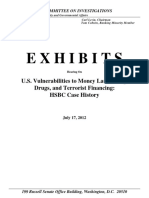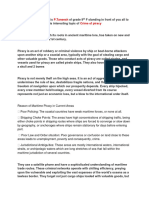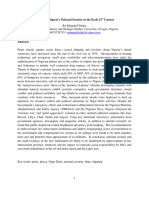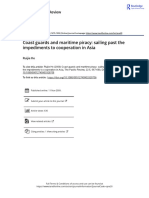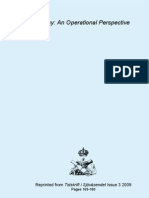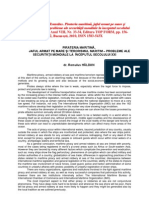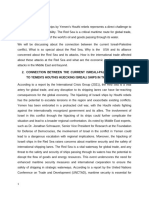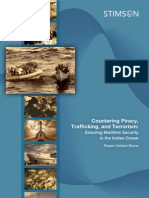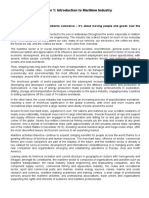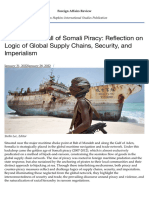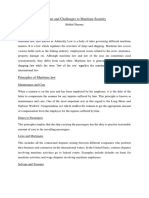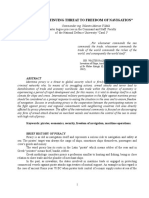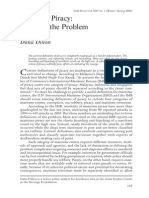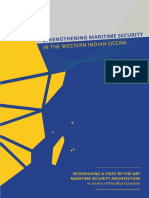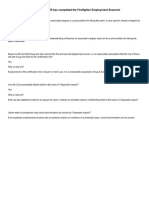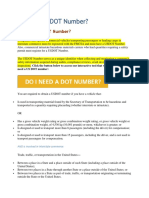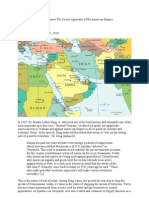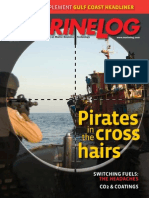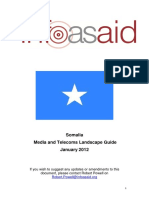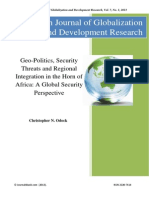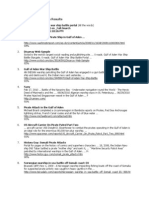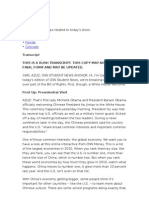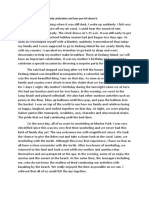Maintaining Security
Maintaining Security
Uploaded by
seymourwardCopyright:
Available Formats
Maintaining Security
Maintaining Security
Uploaded by
seymourwardOriginal Description:
Copyright
Available Formats
Share this document
Did you find this document useful?
Is this content inappropriate?
Copyright:
Available Formats
Maintaining Security
Maintaining Security
Uploaded by
seymourwardCopyright:
Available Formats
Security threats and challenges to maritime supply chains
Vijay Sakhuja
The current wave of globalization has had a profound impact on every state of the world, be it landlocked or coastal, resulting in greater access to resources, raw materials and markets. Much of this has been facilitated by a modern and burgeoning sea-based trading system. Today, nearly 80% of global trade is transported in ships hulls. States have invested significant resources in maritime infrastructure, containerized trade, energy supply chains, information technology-driven cargo movements and processes accelerating financial transactions in order to harness the benefits of globalization. Further, most states have linked the hinterland with the littoral through a complex network of roads and rail, resulting in rapid movement of goods. The United Nations Conference on Trade and Developments Review of Maritime Transport 2009 notes that in 2008 world sea-borne trade increased by 3.6% to reach an estimated 8.17 billion tons, global fleet tonnage witnessed year-on-year growth of 1.19 billion deadweight tons (dwt), and world container port throughput grew by an estimated 4% to reach 506 million TEUs.1 This is despite the global economic downturnglobal GDP expanded by only 1.8% in 2008.2 While globalization may have acted as a catalyst for the growth of international commerce, it has also unleashed and aggravated disparity among regions, societies and people. In some cases, inequalities induced by globalization have created conditions for the rise of violent nonstate actors that possess significant capabilities to challenge the emergent economic order. A careful examination of the impact of globalization reveals that the sea-based trading system is vulnerable to piracy, terrorism, illegal drug trafficking, gun-running, human smuggling, maritime theft, fraud, illegal fishing and pollution, which can all disrupt maritime supply chains to the heavy cost of the global economy. Securing maritime supply chains against disruption thus presents an enormous challenge for the globalized world. States have invested significant political, diplomatic and military resources to ensure the smooth flow of commerce and chosen sophisticated security strategies and systems so as not to slow down international trade and impede economic growth. In essence, operational strategies are primed to ensure that trade flows unhindered and sea lines of communication are protected. This paper examines the threat of piracy and terrorism to maritime supply chains. It begins by identifying the geography of operation of pirates and terrorists, i.e. littorals, and highlights the threats and challenges posed by non-state actors. It then elaborates on the regional and international cooperative initiatives targeting the problem of piracy and terrorism. Finally, the paper argues for a UN-mandated force for anti-piracy and counter-terrorism.
Vijay Sakhuja is Director (Research) of the Indian Council of World Affairs, New Delhi, and Visiting Senior Research Fellow, Institute of Southeast Asian Studies, Singapore.
Maritime security
Contested littorals
Littoral is an area where sea meets land. These spaces are rich in diversified marine living resources and are hubs of urbanization: nearly 60% of the worlds population lives within 100km of the waterfront. A large number of cities with populations exceeding one million are located in coastal areas. The littorals are hubs of intense economic activity linked with maritime trade, which pivot on an intricate maritime infrastructure (ports, harbours, oil and gas terminals and rail/road system) as well as networks connecting the littoral with the hinterland. Such infrastructure provides the sinews for the economic growth and comprehensive development of the state. Littorals provide the muscle for economic growth and development, but in some cases they can also be focal points of social dysfunction due to economic disparities. Lack of governance and an ineffective social security apparatus have in some coastal areas created favourable conditions for illegal activities.3 In the absence of good governance, criminal and subversive elements flourish and these can disrupt social harmony. Governance of littorals is thus a major challenge for civil security agencies. Ineffective governance has also left the marine resources that littorals provide vulnerable to attack by unsustainable fishing, poaching and dumping of chemicals. These activities can generate tensions among states, and can even result in local populations taking up arms in an effort to protect their legitimate interests, as is the case in Somalia. In essence, while littorals provide economic muscle, they are often areas of social disorder. The nexus between organized crime networks and terrorist groups with transnational capability can potentially exploit these spaces to conduct their operations, and this poses significant challenges for states.
Mapping sea piracy
Sea piracy has existed since ancient times and its scourge has been well documented. The Romans and the Greeks in the Mediterranean and the Srivijaya rulers in South-East Asia dispatched navies to fight pirates and protect trade. In more recent times, stories of sea piracy have generally been restricted to romanticism on the silver screen: audiences were exposed to glamorous swashbuckling pirate and buccaneer icons such as Blackbeard, Long John Silver, Anne Bonny and Black Sam Bellamy. However, over the last 20 years the menace of piracy has had a very real impact on international shipping, with horrifying incidents of hostage-taking and assault, of crew members traumatized, left adrift or even killed. The maritime community has consistently voiced its concern about the menace of piracy and called on states to bring order at sea for the safety of crews and the security of trade. There are political, economic, social, legal and security reasons for the recent spurt in piracy, which include political instability resulting in lack of governance of the littorals, the absence of
two l 2010
Security threats and challenges to maritime supply chains
political will on the part of states to fight piracy, poor socio-economic conditions pressurizing local populations to commit piracy for survival, inadequate military capability to respond, and the absence of a robust legal system to prosecute despite laws against piracy (pirates have long been hostis humani generisenemies of mankindunder public international law, and the 1982 United Nations Convention on the Law of the Sea provides significant powers to states to prosecute pirates).4 Pirates have been active in Asia (South China Sea, South-East Asia and South Asia), the Persian Gulf, Africa (the Horn of Africa and the west coast), the Caribbean and Latin America. In recent times South-East Asian waters, particularly the Straits of Malacca, and the Gulf of Aden in East Africa have been the hot spots of sea piracy and attracted international attention. The Straits of Malacca is a vital sea space connecting the Indian Ocean to the Pacific Ocean, which experiences a high density of shipping traffic. Over 60,000 vessels transit the Straits each year, carrying a variety of cargo including the critical energy needs of the Asia-Pacific countries. According to the London-based International Maritime Bureau (IMB), a global watchdog monitoring crime and malpractice at sea, in 2008 and 2009 only two incidents of attempted/ actual piracy of armed robbery were recorded each year for the Straits of Malacca, which is in sharp contrast to the 38 attacks recorded for 2004.5 This is in part because in 2004 the littoral states of the StraitsIndonesia, Malaysia and Singaporecame under intense international pressure to ensure the safety of merchant traffic. The United States announced its involvement in policing the Malacca Straits with the Regional Maritime Security Initiative (RMSI),6 under which it planned to deploy Marines and Special Forces with high-speed boats to combat terrorism, piracy, gun-running and drug smuggling. Close on its heels, the Lloyds Market Association and International Underwriting Associations Joint War Committee (JWC) declared the Straits of Malacca, along with several maritime areas in West Asia and Africa, prone to war, strikes, terrorism and related perils.7 There was a fear that Al-Qaida could attempt to use pirates as cover to carry out attacks on merchant shipping. The JWC announcement had a severe impact on shipping, with insurance companies levying higher premiums for ships transiting the Straits of Malacca. The littoral states instituted a series of proactive counter-piracy measures, including surveillance and reconnaissance of the Straits through coordinated sea and air patrols, intelligence sharing and security enhancement.8 Like the Straits of Malacca, the Gulf of Aden is an important sea passage that connects the Indian Ocean with the Mediterranean Sea through the strategic choke points of Bab-al-Mandab and the Suez Canal. The Gulf witnesses annual traffic of around 20,000 vessels. According to the IMB, the waters around Somalia and the Gulf of Aden are the major piracy hot spot; in 2006, there were just 20 reported piracy incidents, but in 2008 there were 111 attacks. The IMB annual report for 2009 notes that there were 196 incidents of attack on shipping, 46 vessels were hijacked, and 857 crew members taken hostage in the Gulf of AdenSomalia.9
Maritime security
Piracy has been rampant in the Gulf of Aden, particularly off Somalia and Yemen, because of lack of governance in the littorals. Foreign fishing vessels have exploited this lack of governance: Somali waters have become poaching grounds for modern fishing fleets from Europe, Thailand, Yemen, even from as far as China and Korea, and the local fishermen, who rely on traditional fishing methods, have been deprived of their catch.10 Somali waters have even become dumping grounds for radioactive materials such as uranium, lead, mercury and industrial chemical waste.11 The local fishing community, infuriated by these developments, has cited poaching as the primary reason for taking to piracy: it took it upon itself to protect the countrys 2,300 nautical miles of coastline and the exclusive economic zone (EEZ) that extends 200 nautical miles into the sea.12 The Somali Marines or Ocean Salvation Corps, having first taken up arms against poachers, have moved on to targets unrelated to fishing such as merchant ships. Although Somalias Transitional Federal Government acknowledges the problem of illegal fishing, it has argued that this does not justify these boys to now act like guardians. They are criminals. The world must help us crack down on them.13 A large number of Somali fishermen are actively engaged in the business of piracy and are now attacking and hijacking vessels as far as 1,000 nautical miles from the Somali coast on a regular basis, receiving huge sums in ransom money.14
Terrorism at sea and from the sea
During the last few decades, several terrorist groups have mushroomed across the globe. Notwithstanding the fact that the sea is a complex medium, and requires great mastery to conduct attacks, these groups have developed significant capability to conduct attacks at sea, under the sea and more recently from the sea. Nearly two dozen terrorist groups have been identified as having engaged in acts of terrorism at sea and have struck in Latin America, Europe, the Middle East, South Asia and South-East Asia.15 Significantly, the terrorist groups have kept pace with modern navigation technologies and developed innovative tactics to challenge maritime forces. They have successfully attacked a range of targets, from poorly secured platforms such as oil tankers and ferries to making forays against highly defended warships, port infrastructure and oil terminals. Besides lethal weaponry, some terrorist groups have carried out attacks by employing marine leisure equipment (scuba diving equipment and diving apparatus, sea scooters, speedboats and tourist submarines) and devices and explosives that have commercial use. These items are all easy to acquire without inviting suspicion, and can be effortlessly deployed at sea and underwater. There are fears that terrorists may smuggle an unsophisticated nuclear or radiological device into a ship or transport it by container and detonate it in a port, creating a doomsday scenario. We have already seen that the unconventional nature of the tools and innovative tactics employed by terrorist groups has at times overwhelmed security forces.
two l 2010
Security threats and challenges to maritime supply chains
The Liberation Tigers of Tamil Eelam (LTTE) in Sri Lanka, Al-Qaida in Pakistan and Afghanistan (with strong links with other groups in Asia), Jemaah Islamiyah in South-East Asia, the Moro Islamic Liberation Front (MILF) and the Abu Sayyaf Group in the Philippines, and Hizbullah, Hamas and other smaller groups in the Middle East have all demonstrated a capability to attack targets either at sea or by sea successfully. Significantly, newer groups are also taking to the seas and exploiting the littorals to attack targets on shore: Lashkar e Toiba (LeT), a group based in Pakistan, has invested in maritime attack capabilities and successfully employed them to carry out attacks in Mumbai in November 2008. Until very recently, the LTTE (destroyed by the Sri Lankan military in 2009) was the only terrorist group endowed with the capabilities to be regarded as a small non-state sea power. It controlled ports and harbours and had an ocean-going fleet, a global trading network that supported its economy, a fishing fleet, shipbuilding yards and a navy. This navy, also known as the Sea Tigers, skilfully engaged in multi-vessel wolf pack attacks using high-speed boats against the Sri Lankan Navy. Its underwater capability was built around trained divers deployed as saboteurs to carry out attacks against naval ships; improvised sea mines similar to limpet mines; and semi-submersible human torpedo and submersible platforms such as mini-submarines. With this capability the LTTE exercised control in the waters off Jaffna in north-east Sri Lanka. At sea, Al-Qaida is best known for its spectacular attacks against the USS Cole in 2000 and on the French tanker MV Limburg in 2002. Its operatives successfully rammed into these vessels with high-speed boats laden with explosives. The USS Cole incident forced navies across the globe to re-examine the changing nature of terrorist groups tools and tactics. Over the years, Al-Qaida operatives have developed a sophisticated knowledge of naval warfare. This revelation emerges after detailed documentation similar to a naval manual was discovered with Al-Qaida operatives. The documentation provides details for the use of limpet mines: the procedure for attaching them to a ships hull; the location for best effect in different types of ships; and the amount of explosive to be used.16 Al-Qaidas interest in underwater capability is revealed in the interrogation of Abd al-Rahim al-Nashiri, nicknamed Prince of the Sea, an alleged Al-Qaida mastermind.17 In 2003, the Singaporean authorities arrested 15 suspected Islamic militants linked to Al-Qaida: elaborate plans had been drawn up to attack US naval vessels at Changi Naval Base.18 The Abu Sayyaf Group, based in Basilan Island, has been engaged in banditry and piracy in Philippine waters. It has a fleet of high-speed stealth boats fitted with machine guns. The group is responsible for the 2004 attack on Superferry 14, which killed over 100 people. Until 2008, Lashkar e Toiba had always operated on land. It is plausible that it may have been encouraged to take to the sea by groups with maritime capability. In November 2008, LeT operatives left Karachi in an unknown vessel, hijacked an Indian fishing craft and killed some
Maritime security
of the crew.19 Just before reaching the Indian coast, the operatives boarded inflatable craft and landed on an unsecured waterfront of south Mumbai. The terrorists were in constant communication with their leaders in Pakistan through satellite telephones. They were proficient in using the Global Positioning System (GPS) for navigation, had good knowledge of the landing points in south Mumbaiobtained through open source digital mapsand were well trained in operating high-speed inflatable craft. Their plans included using hostages as shields to escape, again by sea. In Palestinian territory, armed non-state actors have a history of carrying out operations at sea. In 1985, Palestinian guerillas hijacked the Achille Lauro, an Italian cruise liner, and demanded the release of a group of Palestinians detained in Israeli prisons. A US citizen was killed on board. The Achille Lauro incident led to the formulation of the 1988 Convention for the Suppression of Unlawful Acts against the Safety of Maritime Navigation. More recently, in November 2002, Palestinian Islamic Jihad terrorists detonated a boat-bomb off the coast of Gaza, which damaged an Israeli patrol boat, and just two months later Palestinian operatives tried to blow up an Israel Navy vessel using a small boat-bomb. In 2006 Hizbullah successfully fired a C-802 surface-to-surface missile against the Israeli Navys INS Hanit.20 The ship was partially damaged; perhaps more disturbing was the knowledge that non-state actors are able to acquire highend military hardware. Israeli military intelligence claims that Hamas is interested in acquiring C-802 cruise missiles from Iran.21 Some non-state armed groups even own merchant ships. For instance, the LTTE had acquired its own fleet of at least a dozen vessels registered in Honduras, Panama and Liberia to run a legitimate commercial activity as well as to facilitate the transport of military hardware, including arms and ammunition. Much of this cargo was transferred to smaller vessels on the high seas that could then be ferried to LTTE-controlled landing-points. The smaller vessels were also used to transport civilian cargo such as food grain, building materials and other general necessities of daily life. It is believed that Al-Qaida has a fleet of merchant vessels too, but this has not been corroborated by any hard evidence.
Reactions and response
Historically, states have deployed their militaries to protect overseas territories and trade and even built international coalitions to do so. In recent years, nations have established multilateral arrangements to fight non-state armed groups at sea, some of whom have political motives. There is a realization that the limitations for any individual state to respond unilaterally to multiple threats across the globe make cooperation or global partnerships important. It is generally agreed that such partnerships facilitate the rapid and most effective deployment of forces. However, in order to succeed, the partners need to have sufficient political and strategic interoperability to enable them to mandate naval forces to engage in joint maritime operations.
two l 2010
Security threats and challenges to maritime supply chains
The war on terror has required the full spectrum of diplomatic, economic, military, law enforcement, intelligence and public opinion networks to work together. It has shown that common interests, values and a coordinated approach are critical to combat common security concerns. Further, it has emerged that even a country as powerful as the United States needs international support to obtain intelligence, undertake surveillance, track terrorists and physically reach its enemies. Currently, warships from over two dozen navies from Asia, Europe, the Middle East, the Russian Federation and the United States are operating in the Gulf of Aden, under various joint task forces or independently, to fight pirates and terrorists. States have established a number of maritime arrangements that pivot on joint operations, multilateral exercises, intelligence sharing, training and capacity building. Maritime security concerns are being discussed in multilateral forums such as Asia-Pacific Economic Cooperation, the Association of Southeast Asian Nations Regional Forum, the Council for Security Cooperation in the Asia Pacific, the East Asia Summit, the Indian Ocean Naval Symposium, the Shangri-La Dialogue and the Western Pacific Naval Symposium. The littoral states of the Straits of Malacca have instituted a range of counter-piracy initiatives such as joint sea patrols (MALSINDO), air patrols (Eyes in the Sky initiative, with the added participation of Thailand), intelligence sharing mechanisms and intergovernmental discussions on maritime security. It is widely acknowledged that these initiatives have been instrumental in the decline of piracy in the Straits of Malacca. In addition, the Regional Cooperation Agreement on Combating Piracy and Armed Robbery against Ships in Asia (ReCAAP) is the first Asian intergovernmental agreement to enhance the security of regional waters and involves members of ASEAN as well as Bangladesh, China, India, Japan, the Republic of Korea and Sri Lanka.22 While the Straits of Malacca is a success story, piracy in the Gulf of Aden remains worrisome. In the wake of a surge in attacks, the United Nations Security Council adopted four resolutions in 2008 calling upon states to provide assistance to Somalia to counter piracy in the Gulf of Aden and deploy naval forces.23 Currently, Combined Task Force 151 (CTF-151, a multinational task force involving over 30 ships from a number of countries including the United States), European Union Naval Force Somalia (EUNAVFOR), and a number of ships and aircraft from several Asian countries (China, India, Japan, Malaysia, Republic of Korea, Singapore), Australia, Iran, the Russian Federation and Saudi Arabia are deployed in the Gulf of AdenSomalia coastIndian Ocean region to conduct counter-piracy operations and escort UN World Food Programme ships carrying humanitarian supplies for the Somali people. These navies operate individually and under multilateral naval arrangements and meet in Bahrain on a monthly basis under the Shared Awareness and Deconfliction (SHADE) arrangement.
Maritime security
As regards terrorism, several UN Security Council resolutions have called on states to cooperate and fight terrorism, such as resolution 1540 of 2004. Also, in the wake of the September 2001 attacks in the United States, a number of International Maritime Organization (IMO) initiatives have been introduced to make maritime trade more safe, secure and immune to disruptions, including the International Ship and Port Facility Security Code (ISPS). The Container Security Initiative (CSI) and the Customs-Trade Partnership against Terrorism (C-TPAT), which both originated in the United States, are also being encouraged elsewhere in the world. The main purpose of these initiatives is to reduce the likelihood of maritime-vectored terrorism. Some programmes have been less successful: the Proliferation Security Initiative to intercept illegal transport of weapons of mass destruction and related materials and the 1,000 Ship Navy, which seeks to build a global partnership of maritime forces including merchant shipping, have not found favour among some states, who perceive the projects as intrusive, in violation of national laws, and only serving the purpose of certain countries.
A case for blue hulls
The international initiatives to combat piracy and terrorism have so far shown that states share a commitment to develop a broad and substantive agenda for mutual trust and confidence. They are particularly significant for those countries that do not possess the capability to deploy their navies in distant waters and require assistance to protect their maritime interests. However, it remains to be seen how long states are able to meet the UN call to fight terrorists, defeat pirates and provide safe passage to international shipping. After all, there are financial and operational constraints that must be overcome for prolonged deployment, and these are sure to weigh heavily on the minds of national planners. Efthimios Mitropoulos, Secretary-General of the IMO, would like to see governments committing sufficient numbers of warships, military aircraft and surveillance assets to the region [Somalia] and to co-ordinate their command and control under the auspices of a United Nations mandate.24 Mitropoulos even suggested a sea-based UN-mandated maritime force similar to forces deployed by the United Nations during crises onshore. There is merit in Mitropouloss observations and suggestions for a UN-mandated antipiracy and counter-terrorism force at sea. A force under the UN flag would be preferable to the international community because it would provide security assurance to smaller states that do not have large navies to patrol their waters or to escort their vessels through piracyprone areas. However, the UN initiative is likely to be seen to fit uneasily within the traditional framework of UN operations: some may interpret a mandate for a naval force as an offensive military activity rather than peacekeeping. It is argued that the coast guard and marine police units would be more suitable for a UN maritime force. The participating units would have to be carefully chosen. Joint training under the United Nations could prove useful in terms of promoting an international mandate to conduct anti-piracy and counter-terrorism operations.
two l 2010
10
Security threats and challenges to maritime supply chains
Concluding remarks
Piracy and terrorism originate in the littorals and, when political instability and poor governance provide ideal conditions for non-state actors to engage in illegal activity with relative impunity, can thrive. Littoral security is a vital dimension of national security and raises several issues and challenges for states that tend to focus their attention on land. While the international community develops international coalitions, partnerships or concerts and strategies to fight piracy and terrorism, it is critical to invest political, diplomatic and economic resources to build the capacity of states that are experiencing chaotic littorals and require proactive governance tools. Political stability and a strong government in Somalia can help international efforts to fight piracy in the Gulf of Aden. Stronger, better governance will help furnish the robust legal instruments that are necessary to prosecute non-state actors. Finally, the globalized world has entered the twenty-first century in a position of uncertainty and due to the rise of violent non-state actors that have posed several serious challenges and threats to the maritime enterprise, using violence with noticeable effect and exploring new tools and tactics to challenge maritime forces. Navies and other maritime security agencies will be under pressure to respond to operationally agile enemies who are constantly engaged in developing innovative strategies, tools and tactics to expand their reach and lethality. Notes
1. United Nations Conference on Trade and Development, 2009, Review of Maritime Transport 2009, Geneva and New York, United Nations, pp. xivxv. TEU stands for twenty-foot equivalent units, a measure used for capacity in container transportation. 2. This is compared with 3.8% in 2007 (International Monetary Fund, 2009, World Economic Outlook: Sustaining the Recovery, Washington, DC, October, Table 1.1, p. 2). 3. For a discussion on the concept of chaos in the littorals, see Edward Hanlon Jr, 2000, Taking the Long View: Littoral Warfare Challenges, in Richard H. Shultz Jr and Robert L. Pfaltzgraff Jr (eds), The Role of Naval Forces in 21st Century Operations, Dulles, VA, Brasseys, pp. 156157). Also see W. Lawrence S. Prabhakar, 2006, Securing Indias Littorals in the Twenty-first Century: Issues and Challenges, Society for the Study of Peace and Conflict, Issue Brief no. 1, August. 4. See Article 105 Seizure of a Pirate Ship or Aircraft, United Nations Convention on the Law of the Sea, signed at Montego Bay, 10 December 1982. 5. International Chamber of Commerce, International Maritime Bureau, 2010, Piracy and Armed Robbery Against Ships: Annual Report 1 January31 December 2009, Table 1, p. 5; International Chamber of Commerce, International Maritime Bureau, 2009, Piracy and Armed Robbery Against Ships: Annual Report 2008, Table 1, p. 5. 6. For more on the RMSI, see Joshua Ho, 2004, Operationalising the Regional Maritime Security Initiative, IDSS Commentary 18/2004, S. Rajaratnam School of International Studies. 7. Lloyds Market Association and International Underwriting Association of London, Joint War Committee, Hull War, Strikes, Terrorism and Related Perils: Listed Areas, 20 June 2005. 8. International Maritime Organization, States Make Progress in Co-operation to Enhance Safety of Navigation, Security, and Environmental Protection in Straits of Malacca and Singapore, Briefing 32, 22 September 2006. 9. International Chamber of Commerce, International Maritime Bureau, 2010, op. cit., pp. 5, 8, 13.
11
Maritime security
10. Paul Salopek, Somali Piracy Like a Resource Swap, Chicago Tribune, 15 October 2008; Clive Schofield, 2009, The Other Pirates of the Horn of Africa, RSIS Commentary 2/2009, S. Rajaratnam School of International Studies. 11. United Nations Environment Programme, 2005, After the Tsunami: Rapid Environmental Assessment, chapter 8 Somalia. 12. Jeffrey Gettleman, Pirates Holding Ukrainian Ship Say They Only Want Money, New York Times, 30 September 2008. 13. Somali diplomat quoted in Jeffrey Gettleman, op. cit. 14. Anti-pirate Attack Guidelines Being Ignored, UN Says, BBC News, 29 January 2010. 15. Rohan Gunaratna, 2001, The Asymmetric Threat from Maritime Terrorism, Janes Navy International, vol. 106, no. 8, October, p. 26. 16. Stefano Ambrogi, Iraq War Could Spur Al Qaeda Sea Attacks in Gulf, Reuters, 21 February 2003. 17. Arabinda Acharaya, 2008, Terrorist Groups with Maritime Terrorist Capabilities, in V.R. Raghavan and W. Lawrence Prabhakar (eds), Maritime Security in the Indian Ocean Region, New Delhi, Tata McGraw-Hill. 18. Ministry of Home Affairs, Singapore, White Paper: The Jemaah Islamiyah Arrests and the Threat of Terrorism, 7 January 2003. 19. Mumbai Terror Attacks (Nov. 2629, 2008), available at <www.hindu.com/nic/dossier.htm>. 20. Alon Ben-David, Hizbullah Hits Israels INS Hanit with Anti-ship Missile, Janes, 18 July 2006. 21. Israeli Intel: Hamas to Receive Chinese Cruise Missiles from Iran, World Tribune, 27 January 2009. 22. For more on ReCAAP, visit <www.recaap.org>. 23. United Nations Security Council resolutions 1814 (2008) of 15 May 2008, 1816 (2008) of 2 June 2008, 1838 (2008) of 7 October 2008 and 1846 (2008) of 2 December 2008. 24. Cited in Robert Wright, Plea for UN Force to Fight Aden Piracy, Financial Times, 2 November 2008.
two l 2010
12
You might also like
- Anti Piracy Guidance For Seafarers: Preparedness and ResponseDocument69 pagesAnti Piracy Guidance For Seafarers: Preparedness and ResponseJL032419100% (5)
- Answers To CES CBT Test For Seafarers About Maritime PiracyDocument27 pagesAnswers To CES CBT Test For Seafarers About Maritime PiracyMyo Minn Tun100% (1)
- EXHIBITS 1-99 For July 17 2012 HSBC HearingUR7 PDFDocument530 pagesEXHIBITS 1-99 For July 17 2012 HSBC HearingUR7 PDFseymourwardNo ratings yet
- Service DeliveryDocument21 pagesService DeliveryseymourwardNo ratings yet
- A Hijacking - Movie Analysis: Negotiation ProjectDocument7 pagesA Hijacking - Movie Analysis: Negotiation Projectsrishti sharmaNo ratings yet
- STSDSD (1 - 5)Document59 pagesSTSDSD (1 - 5)Prathyush ShankarNo ratings yet
- STSDSDDocument179 pagesSTSDSDdbahidbNo ratings yet
- Shipping and Port Security: Challenges and Legal Aspects: Zillur Rahman BhuiyanDocument12 pagesShipping and Port Security: Challenges and Legal Aspects: Zillur Rahman BhuiyanPapa Mamadou DIOPNo ratings yet
- Responses and Challenges of International ActorsDocument5 pagesResponses and Challenges of International Actorsedmealem mekuriyawNo ratings yet
- Mallaca Strait IssuesDocument4 pagesMallaca Strait IssuesLuQmanNo ratings yet
- Thesis On Piracy at SeaDocument4 pagesThesis On Piracy at SeaPaperWritingServiceSuperiorpapersCanada100% (2)
- Maritime Piracy ThesisDocument4 pagesMaritime Piracy Thesisgjh2y8s8100% (2)
- Maritime Security Threats in AfricaDocument7 pagesMaritime Security Threats in AfricaJohn Anthony DanaNo ratings yet
- Beneath the Waves: Navigators' Nightmares and Modern Piracy Along the Coasts of SomaliaFrom EverandBeneath the Waves: Navigators' Nightmares and Modern Piracy Along the Coasts of SomaliaNo ratings yet
- Crime of PiracyDocument3 pagesCrime of PiracytaneeshkingmakerNo ratings yet
- DISEC (Disarmament and International Security Committee) : Topic Area A:Piracy On High SeasDocument13 pagesDISEC (Disarmament and International Security Committee) : Topic Area A:Piracy On High SeascanךNo ratings yet
- Maritime Piracy in Nigeria - The National Security ImplicationsDocument21 pagesMaritime Piracy in Nigeria - The National Security ImplicationsSILAS RAYNo ratings yet
- Piracy and Nigerias National Security inDocument31 pagesPiracy and Nigerias National Security inking65675No ratings yet
- Thesis Maritime PiracyDocument5 pagesThesis Maritime Piracydivyawatsonstamford100% (2)
- Final Building Maritime Security From LandDocument3 pagesFinal Building Maritime Security From LandasyurasallehNo ratings yet
- Standard Bulletin: Piracy Special EditionDocument12 pagesStandard Bulletin: Piracy Special EditionDrago DragicNo ratings yet
- Choke Points in Maritime TradeDocument9 pagesChoke Points in Maritime TradeAnshu SharmaNo ratings yet
- New and Old Challenges Posed by The Pirates of The Gulf of GuineaDocument2 pagesNew and Old Challenges Posed by The Pirates of The Gulf of GuineaMartin Edwin AndersenNo ratings yet
- Maritime Piracy Armed Robbery and OtherDocument24 pagesMaritime Piracy Armed Robbery and Otherking65675No ratings yet
- Coast Guards and Maritime Piracy Sailing Past The Impediments To Cooperation in AsiaDocument24 pagesCoast Guards and Maritime Piracy Sailing Past The Impediments To Cooperation in AsiaBica CapãoNo ratings yet
- The International Legal Instruments in Addressing Piracy and MaritimeDocument10 pagesThe International Legal Instruments in Addressing Piracy and Maritimear.gkavanozisNo ratings yet
- Maritime Security Cooperation in AseanDocument17 pagesMaritime Security Cooperation in AseanPitipong WongkantharakNo ratings yet
- Barriers To Prosecution: The Problem of PiracyDocument9 pagesBarriers To Prosecution: The Problem of PiracyRobin Kirkpatrick BarnettNo ratings yet
- Counter-Piracy: An Operational Perspective: by Milan VegoDocument14 pagesCounter-Piracy: An Operational Perspective: by Milan VegoMateusz MuchaNo ratings yet
- Maritime Security Cooperation in Indian Ocean: Prospects and Way Ahead For IoraDocument10 pagesMaritime Security Cooperation in Indian Ocean: Prospects and Way Ahead For IoraMohammad Abul HasanNo ratings yet
- Piracy Paper FinalDocument23 pagesPiracy Paper Finalapi-413567964No ratings yet
- Ada463722 PDFDocument28 pagesAda463722 PDFMohd ShajiNo ratings yet
- BISJ MUN position paper 1Document4 pagesBISJ MUN position paper 1soua.y.28No ratings yet
- Somali Piracy DissertationDocument8 pagesSomali Piracy DissertationCollegePaperServiceUK100% (1)
- PIRATERIA MARITIMĂ, JAFUL ARMAT PE MARE SI TERORISMUL NAVAL (Maritime Piracy, Armed Robbery at Sea and Maritime Terrorism)Document21 pagesPIRATERIA MARITIMĂ, JAFUL ARMAT PE MARE SI TERORISMUL NAVAL (Maritime Piracy, Armed Robbery at Sea and Maritime Terrorism)Romulus HALDANNo ratings yet
- The Extent of Maritime Terrorism and Piracy: A Comparative AnalysisDocument27 pagesThe Extent of Maritime Terrorism and Piracy: A Comparative AnalysisGoran JurisicNo ratings yet
- FACPiracy Inquiry Submission 110622 FinalDocument5 pagesFACPiracy Inquiry Submission 110622 FinalbritanniamsNo ratings yet
- Viewcontent CgiDocument19 pagesViewcontent CgiBica CapãoNo ratings yet
- Can An Act of Piracy Be Committed Against An Offshore Petroleum InstallationDocument9 pagesCan An Act of Piracy Be Committed Against An Offshore Petroleum InstallationMarrry FlorenciaNo ratings yet
- Chapter 4 MuliroDocument19 pagesChapter 4 MulirokimenderoNo ratings yet
- Piracy in Malacca StraintDocument16 pagesPiracy in Malacca StraintMartenov IonutNo ratings yet
- INTRODUCTION (1)Document5 pagesINTRODUCTION (1)mandisak695No ratings yet
- Countering Piracy, Trafficking, and TerrorismDocument21 pagesCountering Piracy, Trafficking, and Terrorismmish_ranuNo ratings yet
- Literature Review On Sea PiracyDocument4 pagesLiterature Review On Sea Piracyaflskdwol100% (1)
- Turbulent Waters and Implications Related To ItDocument15 pagesTurbulent Waters and Implications Related To ItSeemab KhanNo ratings yet
- Maritime Trade and Piracy in The Gulf of AdenDocument18 pagesMaritime Trade and Piracy in The Gulf of Adenar.gkavanozisNo ratings yet
- Anti-Piracy and Counter-Piracy Operations: Tactical Bulletin SUW-12-01Document42 pagesAnti-Piracy and Counter-Piracy Operations: Tactical Bulletin SUW-12-01giannis2No ratings yet
- Organised Crime: Piracy: Political ViolenceDocument19 pagesOrganised Crime: Piracy: Political ViolenceDumitru-Neamtu AnaNo ratings yet
- Module 8 - Introduction To Maritime Industry - Notes Chapter 1,2.3,4Document22 pagesModule 8 - Introduction To Maritime Industry - Notes Chapter 1,2.3,4manoj narayananNo ratings yet
- The Rise and Fall of Somali Piracy: Reflection OnDocument4 pagesThe Rise and Fall of Somali Piracy: Reflection OninktainyNo ratings yet
- Threats and Challenges To Maritime SecurityDocument5 pagesThreats and Challenges To Maritime SecurityBitthal SharmaNo ratings yet
- Satinder BabejaDocument30 pagesSatinder BabejaduthindaraNo ratings yet
- Piracy and International Law: Asilka Ancin Iratstvo IN Mednarodno PravoDocument2 pagesPiracy and International Law: Asilka Ancin Iratstvo IN Mednarodno PravoNasif MustahidNo ratings yet
- G1-Seas and OceansDocument5 pagesG1-Seas and Oceansiwhitetower11No ratings yet
- The Anti Maritime Piracy Law in India and Malaysia An Analytical StudyDocument13 pagesThe Anti Maritime Piracy Law in India and Malaysia An Analytical StudyNUR DINIE SANI BINTI HASRUL SANINo ratings yet
- Beyond Drug Trafficking Toward Genuine Security in The CaribbeanDocument2 pagesBeyond Drug Trafficking Toward Genuine Security in The CaribbeanIgnacio PuntinNo ratings yet
- HMUN 10TH SESS POSITION PAPER - IMO - China - Kien TranDocument4 pagesHMUN 10TH SESS POSITION PAPER - IMO - China - Kien Tranacademic.kientn143No ratings yet
- Piracy Threat To Freedom of NavigationDocument10 pagesPiracy Threat To Freedom of NavigationCosti MarisNo ratings yet
- Circular Letter No.3164Document4 pagesCircular Letter No.3164АлександрNo ratings yet
- Dillon Dana Maritvime Piracy Defining The ProblemDocument11 pagesDillon Dana Maritvime Piracy Defining The ProblemGoran JurisicNo ratings yet
- Terrorism On The Sea, Piracy, and Maritime Security: Bojan MEDNIKAROV and Kiril KOLEVDocument13 pagesTerrorism On The Sea, Piracy, and Maritime Security: Bojan MEDNIKAROV and Kiril KOLEVRajamanitiNo ratings yet
- International Maritime Bureau'sDocument1 pageInternational Maritime Bureau'sAngga PratamaNo ratings yet
- Strengthening Maritime Security: in The Western Indian Oce ANDocument8 pagesStrengthening Maritime Security: in The Western Indian Oce ANAnonymous a6yUoyNo ratings yet
- Defending The Cyber Sea LegalDocument17 pagesDefending The Cyber Sea LegalMya SopheaNo ratings yet
- Neurological Problems - DisabilitySecretsDocument3 pagesNeurological Problems - DisabilitySecretsseymourwardNo ratings yet
- REASONDocument1 pageREASONseymourwardNo ratings yet
- Running Head: Recognizing Employee Contributions 1Document9 pagesRunning Head: Recognizing Employee Contributions 1seymourwardNo ratings yet
- Aghion PDocument3 pagesAghion PseymourwardNo ratings yet
- Chiropractic Heuristics: A Study of The ImmaterialDocument67 pagesChiropractic Heuristics: A Study of The ImmaterialseymourwardNo ratings yet
- Chiropractic HeuristicsDocument85 pagesChiropractic HeuristicsseymourwardNo ratings yet
- Killeen Police Academy Training CenterDocument120 pagesKilleen Police Academy Training CenterseymourwardNo ratings yet
- Firefighter Employment ScenarioDocument1 pageFirefighter Employment ScenarioseymourwardNo ratings yet
- COMSA Whitepaper EnglishDocument29 pagesCOMSA Whitepaper EnglishseymourwardNo ratings yet
- Assessing Student Learning in General Education: College of Staten Island March 2007Document48 pagesAssessing Student Learning in General Education: College of Staten Island March 2007seymourwardNo ratings yet
- Ripple: Overview and OutlookDocument19 pagesRipple: Overview and OutlookseymourwardNo ratings yet
- PS4 methodsforassessingSLOs1009 PDFDocument58 pagesPS4 methodsforassessingSLOs1009 PDFseymourwardNo ratings yet
- Free MKT InferencesDocument6 pagesFree MKT InferencesseymourwardNo ratings yet
- China RetailingDocument19 pagesChina RetailingseymourwardNo ratings yet
- I Need A USDOT NumberDocument9 pagesI Need A USDOT Numberseymourward100% (1)
- Bowflex Extreme PDFDocument90 pagesBowflex Extreme PDFseymourward100% (1)
- Contract AdministrationDocument17 pagesContract AdministrationseymourwardNo ratings yet
- Rising China and Africa - SyllabusDocument14 pagesRising China and Africa - SyllabusDavid ShinnNo ratings yet
- 18 Anti-Piracy Weapons For Ships To Fight Pirates PDFDocument20 pages18 Anti-Piracy Weapons For Ships To Fight Pirates PDFNikos StratisNo ratings yet
- Ahmed 2012/13Document97 pagesAhmed 2012/13ec_eiucNo ratings yet
- Andrew Gavin Marshall Yemen The Covert Apparatus of The American EmpireDocument33 pagesAndrew Gavin Marshall Yemen The Covert Apparatus of The American EmpiresankaratNo ratings yet
- Piracy and Armed Robbery Against Ships: Icc International Maritime BureauDocument48 pagesPiracy and Armed Robbery Against Ships: Icc International Maritime BureauRaed AlmestneerNo ratings yet
- Anti-Piracy BMP5 and GCPGDocument10 pagesAnti-Piracy BMP5 and GCPGPetar AleksandrovNo ratings yet
- MarineLog - 07 JUL 2009Document62 pagesMarineLog - 07 JUL 2009jumanleeNo ratings yet
- BensonDocument13 pagesBensonKissa100% (1)
- Samudra ManthanDocument4 pagesSamudra ManthanUday Prakash SahuNo ratings yet
- Mobile Telephone and TaxationDocument92 pagesMobile Telephone and TaxationMustaf MohamedNo ratings yet
- NDU Thesis Final After Def - Maritime Security Challenges in The Indian Ocean RegionDocument70 pagesNDU Thesis Final After Def - Maritime Security Challenges in The Indian Ocean Regionsyed_sazidNo ratings yet
- Horn of Africa Geo Politics PDFDocument24 pagesHorn of Africa Geo Politics PDFAbuAbdur-RazzaqAl-MisriNo ratings yet
- Piracy Against U.S.-Flagged Vessels: Lessons Learned: HearingDocument112 pagesPiracy Against U.S.-Flagged Vessels: Lessons Learned: HearingScribd Government DocsNo ratings yet
- Nmwebsearch Chart Update Results: Block-Colour Block-ColourDocument3 pagesNmwebsearch Chart Update Results: Block-Colour Block-ColourAshish RanjanNo ratings yet
- IISS 2009 The Manama DialogueDocument20 pagesIISS 2009 The Manama Dialogueayan_89No ratings yet
- Impact of Piracy On Somali YouthDocument42 pagesImpact of Piracy On Somali YouthnadifaNo ratings yet
- Sea Guardian Maritime Corp. Anti-PiracyDocument159 pagesSea Guardian Maritime Corp. Anti-PiracyNikkolai Kirril Gementiza Uguis100% (2)
- State v. Usman Judgment On Somalia PiratesDocument38 pagesState v. Usman Judgment On Somalia Pirateslawwebin100% (1)
- Gulf of Aden War Ship Battle PortalDocument113 pagesGulf of Aden War Ship Battle PortalVincent J. CataldiNo ratings yet
- CAB 174 April 2011Document30 pagesCAB 174 April 2011marinedgeNo ratings yet
- Piracy at SeaDocument35 pagesPiracy at Seasandeep100% (1)
- Stable Seas Somali Waters FINALDocument35 pagesStable Seas Somali Waters FINALAbdullahi MohamedNo ratings yet
- CNN Student NewsDocument102 pagesCNN Student NewsFutzu YenNo ratings yet
- Masterscriptie Wouter Klijnsoon PDFDocument121 pagesMasterscriptie Wouter Klijnsoon PDFnatiteli ameriNo ratings yet
- Describe An Important Family Celebration and How You Felt About ItDocument7 pagesDescribe An Important Family Celebration and How You Felt About ItAMALIANo ratings yet
- Thesis On Piracy at SeaDocument4 pagesThesis On Piracy at SeaPaperWritingServiceSuperiorpapersCanada100% (2)


